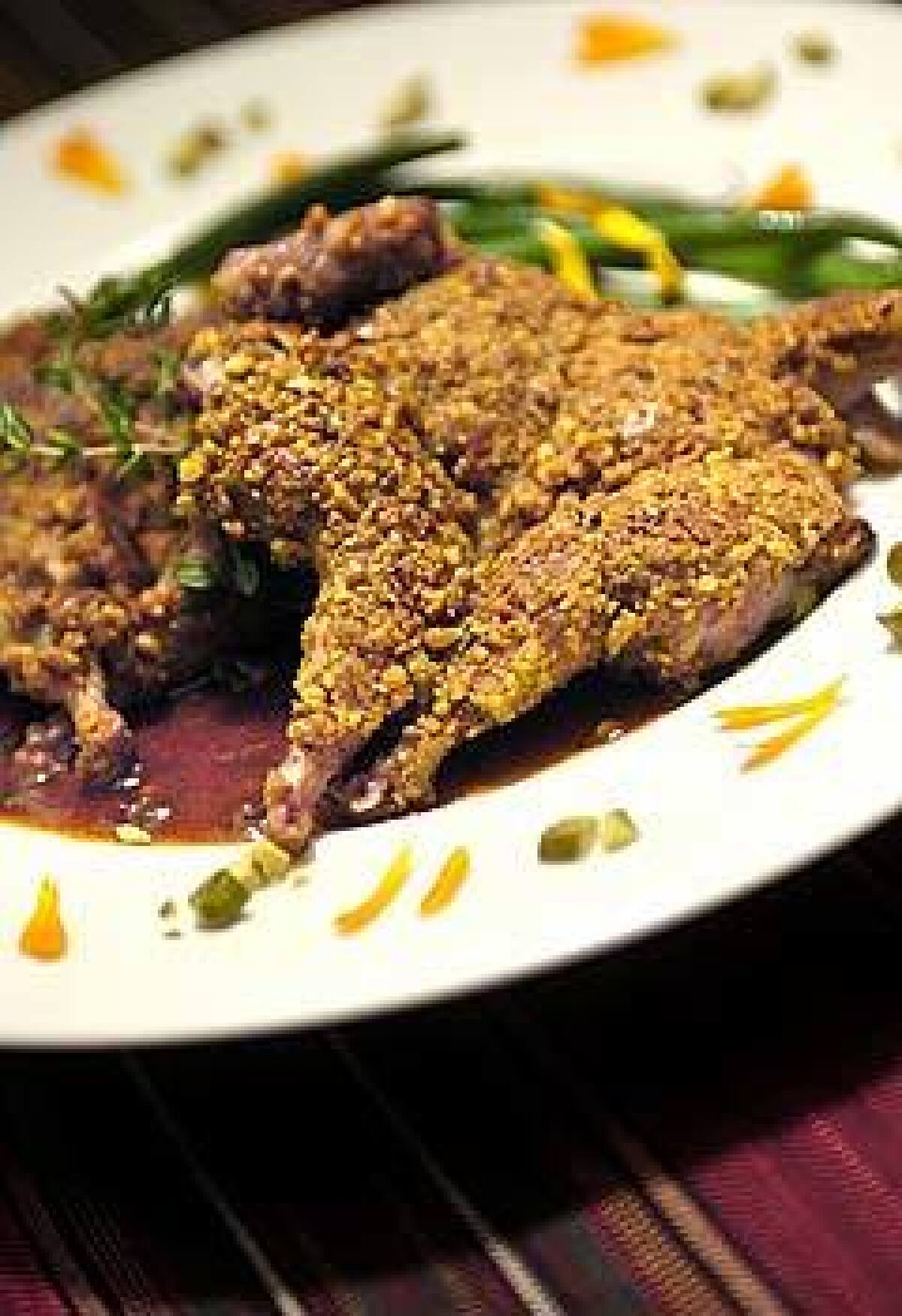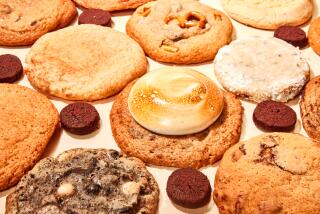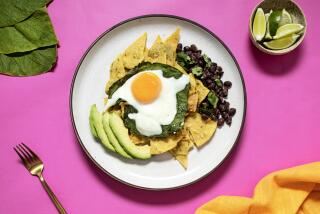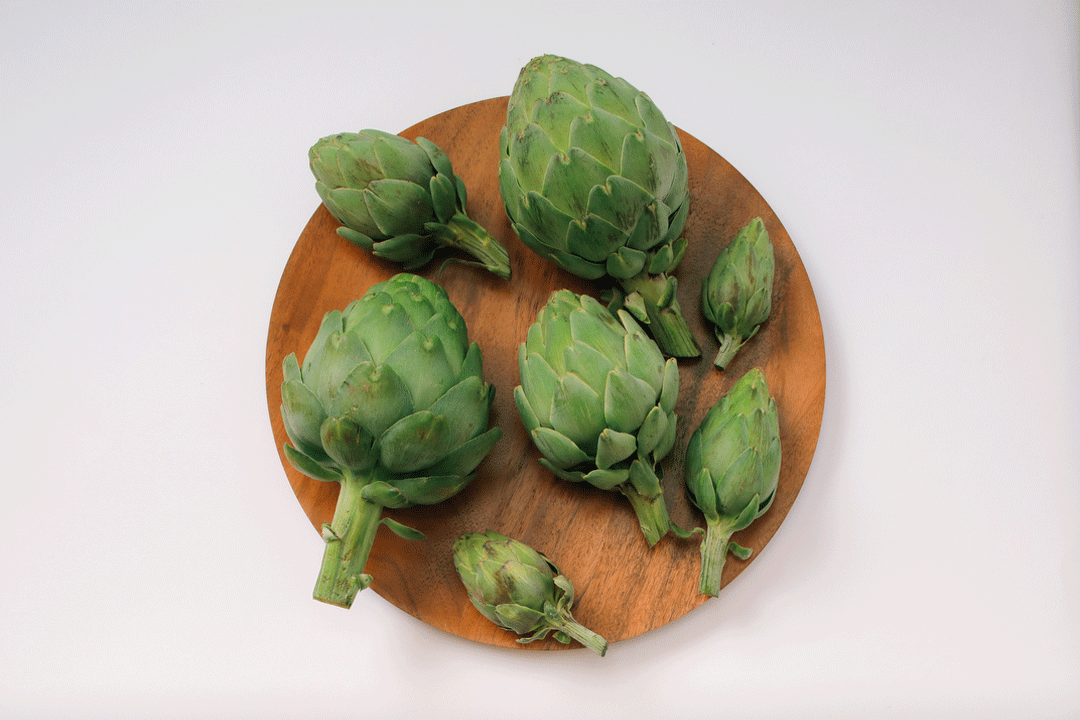The dazzling crunch

I used to buy pistachios just for parties, as a little luxury. For cooking, they seemed too pricey and too tempting — you have to buy twice what you need for a recipe when you know you’ll be shelling one for the cook and one for the bowl.
But a funny thing happened while I was chopping walnuts: Pistachios went mainstream.
These days they almost seem like the white truffle oil of the nut world: once an extravagance, now inescapable. In the last few weeks alone, I’ve had them in restaurants as a filling in ravioli, a crust on seared duck breast and lamb and an essential element of several salads; they even turn up in everything from soup to mole. And that’s not even counting all the ways they surface in desserts.
But every bite makes me realize there’s a big difference between truffle oil and pistachios. The little green kernels are the real deal. They look and taste exotic, and those attributes come naturally.
They will always have the power to dazzle, whether simply set out with cheese and wine or baked into some elaborate torte, but these days they’re not just accessible but affordable. They’re even sold shelled.
My impression of pistachios was formed in my childhood back in the last century, when the only ones you could buy were runty and red and were sold about three to a packet. Those mostly came from far off in the Middle East, where they were dyed to cover the discolorations in the shell from the dusky red husks that encased them. They were good, but they were a lot of work and a lot of mess for the money.
California has been growing them since 1880 or so, but it was not until 1976 that the first commercial crop came onto the market and changed cooks’ lives forever. In the last five years alone the harvest has doubled, to more than 300 million pounds. That is one huge mountain of nuts, and it’s a big reason you can find pistachios just about anywhere for as little as $3.99 a pound. The last pecans I bought were twice that.
California pistachios, a variety called Kerman, also are much more appealing than the kind I grew up eating. They’re uniformly fat and meaty, they’re fresh-tasting, and they’re never a stain hazard for hands because they are processed fast, before the shells can deteriorate.
Middle Eastern pistachios have improved as well — more and more stores are selling undyed Iranian and Turkish varieties, which are skinnier and crunchier and have a duskier flavor. Unfortunately, they are two to three times as expensive. In Harrods Food Hall in London last fall, I was even able to buy fresh pistachios, still in their soft and colorful husks. Their texture was less crunchy, and the flavor was a revelation, like pine nuts right out of the shell.
Pistachios have undeniably benefited from California throwing its substantial marketing muscle behind them, pushing the nuts as a health food, a snob food, a snack food and a convenience food. The Internet home page of the state’s pistachio commission looks as if it wandered in from a particularly dreamy women’s magazine. You have to read carefully to understand that it’s not about fashion but about food.
The go-anywhere nut
Luckily, pistachios are an increasingly easy sell as Americans have gotten away from seeing fat as the villain on the plate. All tree nuts happen to be high in protein as well, and the nutrients in them balance out the relatively high calories. (Researchers willing to prove any thesis if underwriting is provided are also jumping onto the pistachio bandwagon to tout their healthful properties — but then someone even recently proved that hot chocolate has antioxidant properties, so that’s no surprise.)Cookbooks have been slow to catch up to all the great advances in pistachios, but maybe that’s because these colorful nuts can go anywhere an almond or a hazelnut can go. No one needs to write new recipes, only substitute freely. In every case, pistachios will look better and taste more dramatic than almost any nuts but macadamias.
A few chopped fine make a crunchy garnish for a bowl of soup, whether hot squash or cold cucumber. A lot more can jazz up a spinach salad or take pesto into another dimension. Pistachios are also the most seductive partner for hard-sell vegetables such as cauliflower and turnips; that little flash of green makes a big difference.
Some of the most impressive ways to serve pistachios are the most direct. I once had an unforgettable dish of pennette in Venice that was nothing more complicated than cream, Gorgonzola and lots of crunchy pistachios, the sum much more than the parts. (It’s so rich, though, that it’s best served the way the Italians do: as a small course before a light fish.)
Pistachios work better than other nuts as a crust for fish or chicken, or even quail. They aren’t as unctuous and oily, and they don’t burn or ooze when you press them into skin or flesh to be seared. With their vibrant color, the inspiration for countless paint companies, they also look more tantalizing than the usual burnt brown nuts.
Pistachios really come into their own in desserts, though. No wonder chefs are busily turning them into puddings and tarts and crème brûlée, or baking them into biscotti and brownies. They give even carrot cake a wake-up call when you substitute them for pecans or walnuts. And they make an exceptional alternative to peanuts in brittle.
Not surprisingly, given their origins in the Middle East at least 7,000 years ago, pistachios have a true affinity for couscous and lamb. (They and almonds are the only nuts mentioned in the Old Testament.) Dried fruits also go exceptionally well with them: apricots, of course, but also cherries and especially cranberries.
Pistachios seem like such natural additions to everything we eat that it’s almost funny to read one of the greatest food writers who ever lived and realize he got them all wrong. Waverley Root, in his encyclopedic “Food,” insisted the nuts’ underlying appeal was their color alone.
“One light-hearted color is lacking for desserts: green,” he wrote. “It is a color easy to find for other departments of the meal, but there are not many green ingredients consistent with the character of cakes, cookies, puddings, and the like.” Apparently he had never heard of mint.
Root did make sense, though, when he added that the pistachio “seems to confer heightened brilliance” on any dish. (The color comes from chlorophyll, the same component that makes leaves on the pistachio tree green.) It’s one reason pistachios are always added to mortadella and pâtés, which certainly don’t need the extra fat.
Shell them yourself
In most cases, salted pistachios work best in recipes. The plain ones are sweet and rich but need just that edge of extra flavor to bring out the fullest taste. I’ve also found that as convenient as shelled pistachios are, you get stronger, fresher flavor from those you hull yourself.Pistachios have come so far that they make the Martian-green ice cream we all grew up eating seem as dated as Jell-O. I hadn’t had any in eons until curiosity drove me to the freezer case the other week. The first surprise was the color: honestly white. The second was the taste, which was way too sweet to my newly refined palate. The real flavor was in the fat green nuts in every spoonful, with no food coloring needed. The pistachio revolution has even come to the cone.
*
Pennette with pistachios and Gorgonzola
Time: 25 minutes
Servings: 8
Coarse sea salt
3/4pound pennette pasta
1 1/2tablespoons unsalted butter
2 leeks, white part only, washed well and very thinly sliced
3/4cup heavy cream
6 ounces Gorgonzola, cut into pieces
1/2 cup shelled salted pistachios, coarsely chopped
Freshly ground white pepper
Freshly grated Parmigiano-Reggiano
1. Bring a large pot of salted water to a rolling boil. Cook the pennette according to the package directions until al dente.
2. While the pasta cooks, melt the butter in a large deep skillet over medium heat. Add the leeks and a dash of sea salt and cook, stirring, until very soft, about 4 minutes. Add the cream and heat to a simmer.
3. Drain the cooked pasta well in a colander and immediately turn it out into the skillet with the leek mixture. Add the Gorgonzola and toss until coated. Add the pistachios and salt and pepper to taste. Continue stirring until well mixed. Serve at once, with freshly grated Parmigiano-Reggiano, if desired.
Each serving: 386 calories; 13 grams protein; 38 grams carbohydrates; 2 grams fiber; 21 grams fat; 11 grams saturated fat; 59 mg. cholesterol; 261 mg. sodium.
*
Pistachio-crusted quail
Total time: 25 minutes
Servings: 8 as an appetizer, 4 as a main course
Note: The sauce is optional. Partially boned quail can be ordered in advance through selected butchers or selected supermarket meat departments.
1 cup shelled salted pistachios, finely chopped (a blender works best)
2 tablespoons flour
1 teaspoon sea salt
Big pinch cayenne
1/2cup milk
1 egg white
1 teaspoon dry mustard
4 tablespoons extra-virgin olive oil, divided
8 quails, backbone and breastbone removed, rinsed
1 cup demi-glace or very rich stock
1 tablespoon green peppercorns, drained, rinsed and crushed with mortar and pestle
1. Heat the oven to 400 degrees. Line a large baking sheet with paper towels and set it aside in a warm spot.
2. Combine the pistachios, flour, salt and cayenne in a shallow dish and mix well. Whisk the milk, egg white and mustard together in a second shallow dish.
3. Heat 2 tablespoons of oil in each of two large nonstick, ovenproof skillets over medium-low heat. Dip the skin side of each quail into the milk mixture, then lay each into the pistachio mixture to coat, pressing the quail in so that nuts adhere, especially to both sides of the legs. Carefully lay the quail crust side down into the hot oil and cook for 3 minutes, until lightly browned. Using tongs, carefully turn the quail over.
4. Transfer the skillets to a hot oven. Roast until juices run clear when the legs are pierced with a skewer, 3 to 5 minutes depending on the size of the quail. (Cook less time if you like pinker quail, longer for well done.)
5. Carefully remove the quail to the prepared baking sheet and keep warm. Return the skillets to the stove top over medium-high heat and divide the demi-glace and crushed peppercorns between them. Bring to a simmer, stirring.
6. Spoon a little of the sauce onto each of 4 to 8 serving plates and lay the quail on top. (Pass any remaining sauce on the side.) Serve at once.
Each serving: 411 calories; 27 grams protein; 11 grams carbohydrates; 2 grams fiber; 29 grams fat; 6 grams saturated fat; 90 mg. cholesterol; 657 mg. sodium.
*
Pistachio-cranberry cookies
Time: 30 to 40 minutes
Servings: About 3 dozen cookies
1 3/4cups flour
1 teaspoon baking powder
3/4teaspoon baking soda
1/2teaspoon kosher salt
3/4cup (1 1/2 sticks) unsalted
butter, softened
1 1/4cups packed light brown sugar
1 large egg
1 teaspoon vanilla
1 cup shelled salted pistachios, coarsely chopped
1/2cup sun-dried cranberries (or dried cherries or diced dried apricots)
1. Stir together the flour, baking powder, baking soda and salt and set aside.
2. Cream the butter and brown sugar together with a wooden spoon until smooth. Blend in the egg and vanilla. Gradually blend in the dry ingredients until well mixed. Stir in the nuts and cranberries.
3. Drop the dough by tablespoons onto ungreased baking sheets, leaving about 2 inches between each. Bake the cookies in a 375-degree oven until light golden brown (centers should be soft), about 10 minutes. Remove from oven and let stand 2 minutes, then transfer to a rack to cool completely.
Each serving: 97 calories; 1 gram protein; 12 grams carbohydrates; 1 gram fiber; 5 grams fat; 2 grams saturated fat; 14 mg. cholesterol; 71 mg. sodium.
More to Read
Sign up for The Wild
We’ll help you find the best places to hike, bike and run, as well as the perfect silent spots for meditation and yoga.
You may occasionally receive promotional content from the Los Angeles Times.










